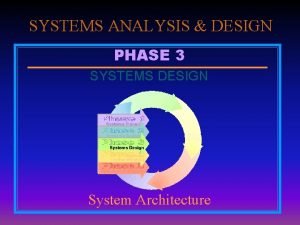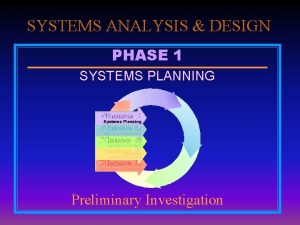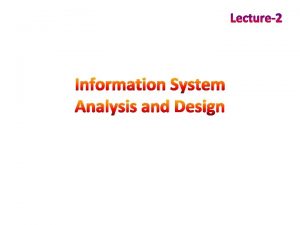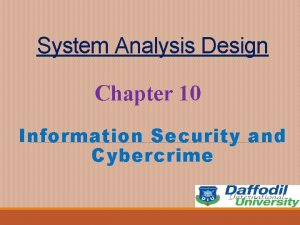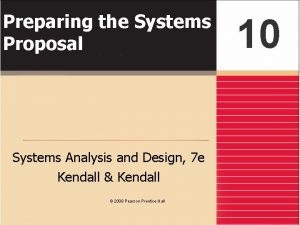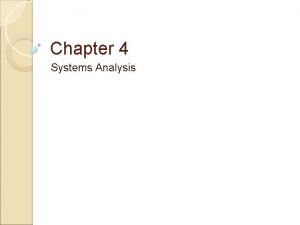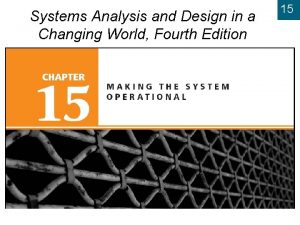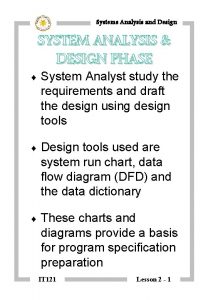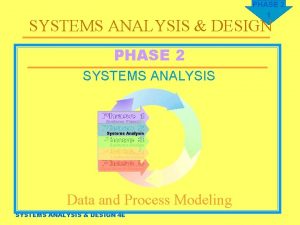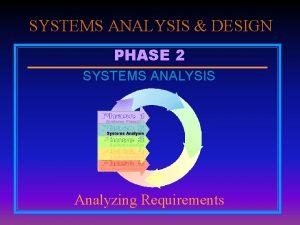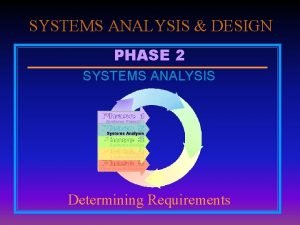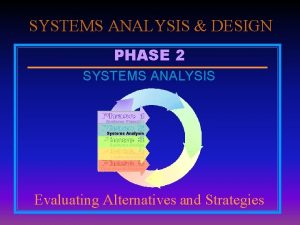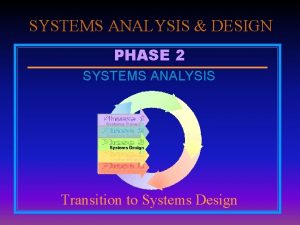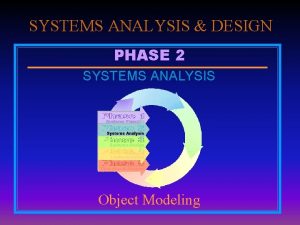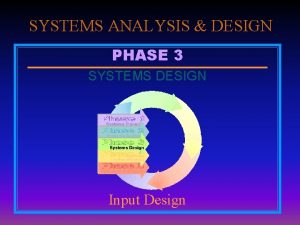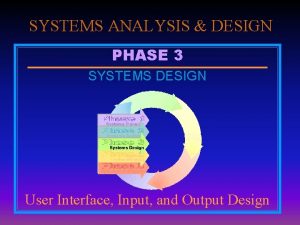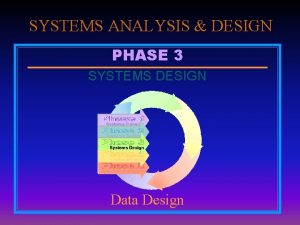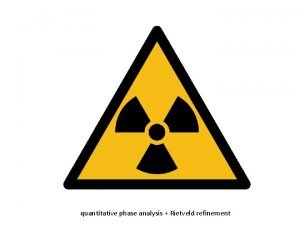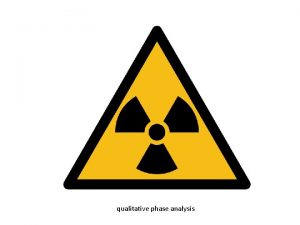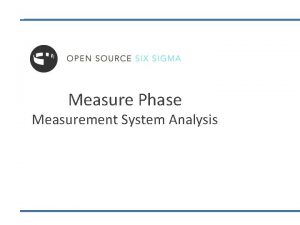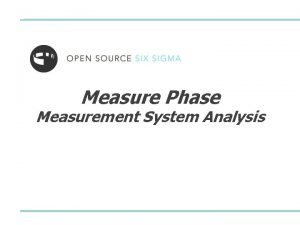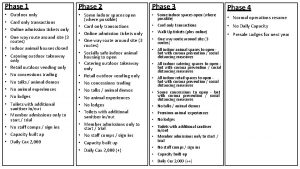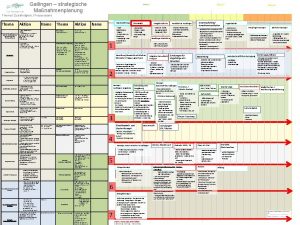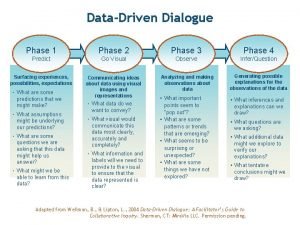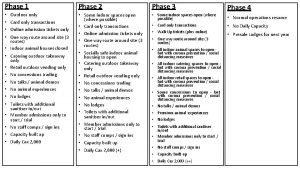SYSTEMS ANALYSIS DESIGN PHASE 3 SYSTEMS DESIGN System















































- Slides: 47

SYSTEMS ANALYSIS & DESIGN PHASE 3 SYSTEMS DESIGN System Architecture

Chapter 9 System Architecture SYSTEMS ANALYSIS & DESIGN 3 E PHASE 3 2

Objectives PHASE 3 3 à Define the term system architecture and describe how it relates to the organization and functions of a business system à Discuss major processing methods, including batch, online, centralized, and distributed processing à Describe local and wide area networks, and explain various network configurations, including hierarchical, bus, star, and ring SYSTEMS ANALYSIS & DESIGN 3 E

Objectives PHASE 3 4 à Explain the characteristics of distributed systems and client/server architecture à Discuss the major processing functions of data input, validating, updating, sorting, and reporting à Describe standard backup and recovery methods for batch and online processing systems SYSTEMS ANALYSIS & DESIGN 3 E

Objectives PHASE 3 5 à Discuss the differences between traditional systems development and object-oriented development à Define the contents of the system design specification document SYSTEMS ANALYSIS & DESIGN 3 E

Introduction PHASE 3 6 à System architecture refers to the logical and physical design of a system, including hardware, software, data, procedures, and people à System architecture is the last task in the systems design phase of the SDLC à The end product of the systems design phase is the system design specification SYSTEMS ANALYSIS & DESIGN 3 E

Processing Methods PHASE 3 7 à An information system operates in an environment that contains one or more specific platforms à An environment, or platform, consists of a particular combination of hardware, systems software, and processing methods à Most companies have progressed from multiuser or stand-alone environments to a powerful, interconnected operating environment SYSTEMS ANALYSIS & DESIGN 3 E

PHASE 3 8 Processing Methods à Online processing à Interactive à Allows a dialog between the user and the system à Increases productivity Click to see Figure 9 -1 SYSTEMS ANALYSIS & DESIGN 3 E Click to see Figure 9 -2

Processing Methods PHASE 3 9 à Batch processing à Data is collected and processed in groups (batches) à Typical method for large amounts of data that are processed periodically, such as paychecks à Batch processing can take place at off-peak times SYSTEMS ANALYSIS & DESIGN 3 E

PHASE 3 10 Processing Methods à Combined online and batch processing à A retail chain is a typical example of online transaction processing and batch processing of accounting data Click to see Figure 9 -3 SYSTEMS ANALYSIS & DESIGN 3 E Click to see Figure 9 -4

PHASE 3 11 Processing Methods à Centralized and distributed processing à Trend has been toward distributed data entry and access, rather than centralized operations à Terminology à Centralized processing à Distributed system à Data communication network à Distributed processing à Distributed database management system (DDBMS) à Data processing center à File server design à Client/server architecture SYSTEMS ANALYSIS & DESIGN 3 E Click to see Figure 9 -5

Local Area Networks and Wide Area Networks PHASE 3 12 à Networks are classified as local area networks (LANs) or wide area networks (WANs) depending on geographical scope and equipment required à A network allows hardware, software, and data resources to be shared à Topology is the way a network is configured à A protocol is a set of data transmission standards à A popular protocol is TCP/IP à nodes are individual locations on a network SYSTEMS ANALYSIS & DESIGN 3 E Click to see Figure 9 -6

Local Area Networks and Wide Area Networks PHASE 3 13 à Hierarchical network à One computer (typically a mainframe) controls the entire network à Satellite processors control lower levels of processors and devices SYSTEMS ANALYSIS & DESIGN 3 E Click to see Figure 9 -7

Local Area Networks and Wide Area Networks PHASE 3 14 à Bus network à A single communication path connects all computers and devices à Information is transmitted in either direction à Devices can be attached or detached at any point without affecting the rest of network SYSTEMS ANALYSIS & DESIGN 3 E Click to see Figure 9 -8

Local Area Networks and Wide Area Networks PHASE 3 15 à Star network à A central computer has one or more workstations connected to it that form a star à The entire network depends on the central computer SYSTEMS ANALYSIS & DESIGN 3 E Click to see Figure 9 -9

Local Area Networks and Wide Area Networks PHASE 3 16 à Ring network à Resembles a circle of computers that communicate with each other à Data flows in only one direction SYSTEMS ANALYSIS & DESIGN 3 E Click to see Figure 9 -10

PHASE 3 17 Client/Server Systems à Divide processing between a central server and one or more clients à A client handles the entire user interface à Data entry à Editing à Data query à Typical transaction à The client submits a request for information from the server à The server responds with the results Click to see Figure 9 -11 SYSTEMS ANALYSIS & DESIGN 3 E Click to see Figure 9 -12

Client/Server Systems PHASE 3 18 à History of client/server systems à Early systems did not produce expected savings à Few clear standards existed à Development costs were high à More hardware and software were required à Problems if handling legacy data à Today, with technology advances, client/server systems represent a major trend in information system architecture SYSTEMS ANALYSIS & DESIGN 3 E

PHASE 3 19 Client/Server Systems à Client/server advantages à Client/server systems are scalable, powerful, and flexible à Businesses can size their systems easily to a changing environment à Communication is possible across multiple platforms à Network load is reduced à Response time is improved Click to see Figure 9 -13 SYSTEMS ANALYSIS & DESIGN 3 E Click to see Figure 9 -14

TRADEOFF PHASE 3 20 à File server designs and client/server systems: why would a company choose one approach over another? à Issues to consider à Number of users who require simultaneous access à Size and characteristics of data files à Processing requirements and physical characteristics à Design decisions involve balancing all factors à The best solution is one that will effectively support current and future business operations SYSTEMS ANALYSIS & DESIGN 3 E

A KEY QUESTION PHASE 3 21 à R/Way has several options à Continue with a file-based system running on the current file server and three workstations à Implement a relational database running on the existing file server platform à Design a new client/server environment à R/Way should consider cost, data file characteristics, ability to handle legacy data, projected growth, and network load SYSTEMS ANALYSIS & DESIGN 3 E

Processing Functions PHASE 3 22 à All processing functions must be documented à Data input and validating à Updating à Sorting à Reporting SYSTEMS ANALYSIS & DESIGN 3 E

PHASE 3 23 Processing Functions à Data input and validating à In online processing the system handles data entry, data input, and validation as a transaction is entered à With batch processing, data entry and validation are separate functions, and a specific way to handle transaction errors is necessary à Require all transactions before any processing à Use a program to correct the transaction file à Create a suspense file for transaction errors Click to see Figure 9 -15 SYSTEMS ANALYSIS & DESIGN 3 E Click to see Figure 9 -16

Processing Functions PHASE 3 24 à Updating (file maintenance) is the process of adding, changing, or deleting records in a master or table file à An audit file is required à Deletion methods à Logical deletion uses flags, and restoration is possible à Physical deletion occurs when data is no longer required SYSTEMS ANALYSIS & DESIGN 3 E

Processing Functions PHASE 3 25 à Sorting à A major task in file-based systems à Transaction files must be sorted before a batch update takes place à In a database environment, physical sorting is not necessary because the DBMS uses indexes when processing, accessing, and displaying records SYSTEMS ANALYSIS & DESIGN 3 E

Processing Functions PHASE 3 26 à Reporting à A major function of online and batch processing systems à Reports can be designed with report generators and 4 GL tools à Most commercial database programs have report generation capability built into the package SYSTEMS ANALYSIS & DESIGN 3 E

Processing Support PHASE 3 27 à Every system will encounter problems à Hardware failures à Systems software errors à User mistakes à Power outages à The objective is to anticipate problems and develop methods to recover from them SYSTEMS ANALYSIS & DESIGN 3 E

Processing Support à Five major support functions à Backup and recovery à File retention à Restart à Start-up processing SYSTEMS ANALYSIS & DESIGN 3 E PHASE 3 28

Processing Support PHASE 3 29 à Backup and recovery à Different strategies are required for batch and online processing à Batch processing involves restoring the backup master and running the transaction file again à Online recovery strategies include à Log (journal) files that recreate transactions à Multiple high-capacity disks à Streaming tape devices Click to see Figure 9 -17 a SYSTEMS ANALYSIS & DESIGN 3 E Click to see Figure 9 -17 b

Processing Support PHASE 3 30 à File retention à The length of time that a file needs to be stored à Determined by combination of legal and processing requirements à Updating cycles are called generations à Grandparent, and child strategy à Legal requirements must be considered SYSTEMS ANALYSIS & DESIGN 3 E

Processing Support PHASE 3 31 à Restart à After a program is interrupted by an error, the first step is to correct the problem and restart the system à A specific restart procedure is required à Common techniques include the use of checkpoints and program status indicators SYSTEMS ANALYSIS & DESIGN 3 E

Processing Support PHASE 3 32 à Start-up processing à Needed when making the transition from the current system to a new system à Create new master files from existing data à Might require special data conversion programs à Start-up processing and file conversion tasks are discussed in Chapter 11, which covers systems implementation SYSTEMS ANALYSIS & DESIGN 3 E

Software Design PHASE 3 33 à Programs required à Identify specific processing functions for each program, and review all process descriptions à Guidelines à Use a separate update program to maintain each master file à Provide a validation program for each update program that does not perform its own validation à Reduce the number of report programs if possible à Identify any programs required to perform special processing SYSTEMS ANALYSIS & DESIGN 3 E Click to see Figure 9 -18

PHASE 3 34 Software Design à Program documentation à In a file-based system, specific program documentation must be assembled à Program identification à Purpose of the program à Processing requirements SYSTEMS ANALYSIS & DESIGN 3 E Click to see Figure 9 -19

Object-Oriented Design PHASE 3 35 à Basic difference in approach à Traditional systems analysis focuses on data flows and procedures à Object-oriented design stresses a bottoms-up approach that focuses on data rather than data flows à SDLC phases may be less clear in an objectoriented approach SYSTEMS ANALYSIS & DESIGN 3 E

Systems Design Completion PHASE 3 36 à System design specification à Presents the complete design for the new system, along with detailed costs, staffing, and scheduling requirements for the next SDLC phase, systems implementation à Programmers rely on the system design specification as they develop the necessary programs and system functions à The contents of the system design specification depend on the company standards and the complexity of the system SYSTEMS ANALYSIS & DESIGN 3 E

Systems Design Completion PHASE 3 37 à System design specification à Management Summary à System Components Details à Program Design à Output Design à Input Design à File and Database Design à Support Processing Design à Environmental Requirements à Implementation Requirements à Time and Cost Estimates à Appendices SYSTEMS ANALYSIS & DESIGN 3 E Click to see Figure 9 -20

Systems Design Completion PHASE 3 38 à Approvals à Review and approval process continues throughout the SDLC à Obtaining design approval from users is especially important à Other approvals are needed from IS department members and management à The system design specific should be distributed well in advance of the presentation SYSTEMS ANALYSIS & DESIGN 3 E

Systems Design Completion PHASE 3 39 à Technical and management presentations à Several presentations usually are made to à Other information systems department staff à Top IS management à Company management à Various decisions are possible including à Proceed with systems development à Perform additional work on system design à Terminate the project SYSTEMS ANALYSIS & DESIGN 3 E

PHASE 3 40 SOFTWEAR, LIMITED à SWL has decided to use True Blue, a consulting firm, to assist in implementing the new ESIP system à True Blue recommends that the ESIP system be designed as a Microsoft Access application à Relational database environment à Client/server capability à SQL command output SYSTEMS ANALYSIS & DESIGN 3 E Click to see Figure 9 -21

SOFTWEAR, LIMITED PHASE 3 41 à System architecture à The development team includes Jane Rossman, Rick Williams, and Becky Evans à Tasks required à Review of ERDs, record designs, processing considerations, backup /recovery procedures, and controls à Design of tables, queries, forms, reports, macros, and code modules à The ESIP system will be a client/server design, with data stored on the payroll server and clients in payroll and human resources SYSTEMS ANALYSIS & DESIGN 3 E

SOFTWEAR, LIMITED PHASE 3 42 à Planning the system à Define all the tasks the new system will perform à List all reports and other required output à ESIP data to be stored on the payroll server à Objects such as forms, queries, and reports to be stored on client workstations à Separating objects from data will provide better security and reduce network loads SYSTEMS ANALYSIS & DESIGN 3 E

SOFTWEAR, LIMITED PHASE 3 43 à Security à Effective security measures are essential to control user access and updates à Passwords à User and workgroup accounts with permission levels à Input from SWL department heads regarding security levels for users à Users will be allowed to create and modify certain forms and reports SYSTEMS ANALYSIS & DESIGN 3 E

SOFTWEAR, LIMITED PHASE 3 44 à Creating the objects à Preparation à Review ERDs and record designs à Verify that the payroll system permits crossplatform access using open database connectivity (ODBC) SYSTEMS ANALYSIS & DESIGN 3 E

SOFTWEAR, LIMITED PHASE 3 45 à Planning the user interface à Objective is a simple, easy-to-use interface à A main form, or switchboard, will display when the ESIP system starts à All ESIP screens will use buttons, menus, and icons à A prototype of the input screens was developed, and user approval obtained SYSTEMS ANALYSIS & DESIGN 3 E Click to see Figure 9 -22

SOFTWEAR, LIMITED PHASE 3 46 à Using Access Basic for procedures and macros à Access Basic is closely related to Visual Basic à Macros can be used to speed up development time à Other procedures will be written in Access Basic à Allows more powerful data manipulation à Customized error messages SYSTEMS ANALYSIS & DESIGN 3 E

SOFTWEAR, LIMITED PHASE 3 47 à Completing the systems design phase à Complete all documentation à Design backup and recovery, file retention, restart and start-up procedures à Develop and distribute a system design specification and complete output, input, file, and program designs à Conduct a management presentation and obtain approval of the ESIP system design SYSTEMS ANALYSIS & DESIGN 3 E
 This is the final task in phase 3: systems design.
This is the final task in phase 3: systems design. Output of design phase
Output of design phase This is the final task in phase 3: systems design.
This is the final task in phase 3: systems design. This is the final task in phase 3 systems design
This is the final task in phase 3 systems design Normal phase vs reverse phase chromatography
Normal phase vs reverse phase chromatography Tswett pronunciation
Tswett pronunciation Mobile phase and stationary phase
Mobile phase and stationary phase Stationary and mobile phase
Stationary and mobile phase Normal phase vs reverse phase chromatography
Normal phase vs reverse phase chromatography Line current and phase current
Line current and phase current Hplc detector types
Hplc detector types Phase to phase voltage
Phase to phase voltage Csce 441
Csce 441 Structured analysis definition
Structured analysis definition Fact finding techniques in sad
Fact finding techniques in sad Feasibility
Feasibility Nine characteristics of system
Nine characteristics of system System security in system analysis and design
System security in system analysis and design Title proposal for system analysis and design
Title proposal for system analysis and design What is candidate system in system analysis and design
What is candidate system in system analysis and design Basic principles of input design
Basic principles of input design User interface design in system analysis and design
User interface design in system analysis and design Dialogue design
Dialogue design Four phase power
Four phase power Systems analysis & design in an age of options
Systems analysis & design in an age of options Gantt chart in system analysis and design
Gantt chart in system analysis and design Systems analysis and design in a changing world
Systems analysis and design in a changing world System analysis and design in a changing world
System analysis and design in a changing world Alan dennis system analysis design
Alan dennis system analysis design Introduction to systems analysis and design
Introduction to systems analysis and design Ssadm tools
Ssadm tools Systems analysis and design 5th edition
Systems analysis and design 5th edition Modern systems analysis and design
Modern systems analysis and design Kendall and kendall system analysis and design
Kendall and kendall system analysis and design Alan dennis system analysis design
Alan dennis system analysis design Systems analysis and design alan dennis
Systems analysis and design alan dennis Systems analysis and design alan dennis
Systems analysis and design alan dennis Systems analysis and design alan dennis
Systems analysis and design alan dennis Systems analysis and design alan dennis
Systems analysis and design alan dennis Systems analysis and design alan dennis
Systems analysis and design alan dennis Systems analysis and design alan dennis
Systems analysis and design alan dennis Ssadm data flow diagram
Ssadm data flow diagram Radar systems analysis and design using matlab
Radar systems analysis and design using matlab Object-oriented systems analysis and design using uml
Object-oriented systems analysis and design using uml A modern approach to systems analysis and design
A modern approach to systems analysis and design Kendall and kendall system analysis and design
Kendall and kendall system analysis and design Kendall kendall
Kendall kendall Systems analysis and design in a changing world
Systems analysis and design in a changing world
